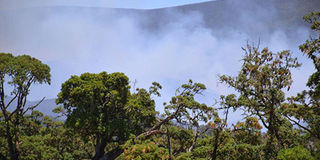Poor resources a catalyst for wildfires

This image taken on March 2, 2019 shows a section of Mount Kenya National Park on fire. More than 80,000 hectares of vegetation was destroyed. PHOTO | FILE | NATION MEDIA GROUP
What you need to know:
- Government relies on private firms such as the David Sheldrick Trust, which has a chopper fitted with facilities to douse fire.
- Experts say dry spells in Mt Kenya are becoming more severe each year due to global warming.
About a month ago, a wildfire was reported near Lake Ellis on the eastern slopes of Mount Kenya National Park.
The next day, February 24, the fire had spread, destroying over 80,000 hectares of vegetation and killing scores of animals, thanks to the ongoing drought, wind, dry underbrush and slow response.
Lake Ellis is a beautiful camping site regarded as the last spot that one can drive to on Mt Kenya.
It is speculated that the fire was started by campers, or loggers or poachers, or criminals who grow bhang in the forest.
Mr Jacob Mutembei, a member of the Community Forest Association based in Chogoria, Tharaka-Nithi County, was among the first residents to accompany Kenya Forest Service (KFS) and Kenya Wildlife Service (KWS) officers for the over 30-kilometre journey to where the fire had spread.
RESOURCES
Arriving at the scene a day after the fire started, they found it had spread from Lake Ellis in Tharaka-Nithi towards Meru and Embu counties.
Fanned by a strong wind, the fire on the moorland vegetation spread fast, making it hard to put it out using bunches of leafy twigs and hand water pumps – the only equipment available.
Fighting forest fires has become a nightmare for many nations. Lack of equipment, poor planning and inaccessible terrain contribute to the spread of fire.
“Exhausted of battling the fire with bunches of leaves, we sometimes sat down and helplessly watched it spread far and wide,” said Mr Mutembei.
The fire was now growing huge, spreading towards Kirinyaga, Nyeri and Laikipia counties and becoming difficult to control.
On Wednesday, February 27 — four days after the fire started — 490 soldiers from the Kenya Defence Forces were deployed, raising the number of fire-fighters to 610.
But the inferno continued consuming the precious water tower, and had by then gutted over 120,000 hectares of vegetation.
EQUIPMENT
After nine days of massive destruction, nature lent a helping hand in the form of a heavy downpour, which put off the fire.
Studies show that forests around the world now face climate change-induced damage, such as prolonged droughts on which wildfires thrive.
In Mt Kenya, foresters believe some area residents have been torching the forest in the belief that it would attract rain and end drought. If the fire-fighters thought the rain had smothered the fire they were wrong.
“We thought all was over and after two days we were informed that the fire had reignited near Kinondoni Lodge in Tharaka-Nithi County,” Mr Mutembei said.
Despite the frequent fire cases if in Mt Kenya and the Aberdares, the KFS has inadequate firefighting gear - it has only four water bowsers and three fire engines - and its response is poor.
GLOBAL WARMING
A chopper bought some years back to help KFS fight fires is only used for conducting aerial surveillance of the forests.
Government relies on private firms such as the David Sheldrick Trust, which has a chopper fitted with facilities to douse fire.
On February 28, Environment and Forestry Cabinet Secretary Keriako Tobiko expressed the need to provide KFS with equipment such as helicopters fitted with water buckets.
“Currently, the only available helicopter bucket has a capacity of 600 litres and covers only 10 metres,” he said.
Chief Forest Conservator Monica Kalenda blamed the rapid spread of the flames on lack of fire breakers.
When the Mt Kenya Forest fire persisted, KWS bought 30 tents to host 90 firefighters. Before that, they travelled up the mountain in the morning to battle the flames and ascended in the evening, beaten and exhausted.
Dry spells in Mt Kenya are becoming more severe each year due to global warming, experts say. And failure to control intruders into the forest is a sure sign that it is waiting to burn once again.





